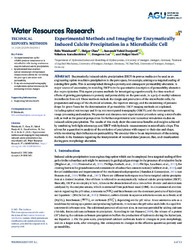Experimental Methods and Imaging for Enzymatically Induced Calcite Precipitation in a Microfluidic Cell
Weinhardt, Felix; Class, Holger; Vahid Dastjerdi, Samaneh; Karadimitriou, Nikolaos; Lee, Dongwon; Steeb, Holger, 2021: Experimental Methods and Imaging for Enzymatically Induced Calcite Precipitation in a Microfluidic Cell. In: Water Resources Research, Band 57, 3, DOI: 10.23689/fidgeo-4325.
 |
Dokument öffnen: |
Enzymatically induced calcite precipitation (EICP) in porous media can be used as an engineering option to achieve precipitation in the pore space, for example, aiming at a targeted sealing of existing flow paths. This is accomplished through a porosity and consequent permeability alteration. A major source of uncertainty in modeling EICP is in the quantitative description of permeability alteration due to precipitation. This report presents methods for investigating experimentally the time‐resolved effects of growing precipitates on porosity and permeability on the pore scale, in a poly‐di‐methyl‐siloxane microfluidic flow cell. These methods include the design and production of the microfluidic cells, the preparation and usage of the chemical solutions, the injection strategy, and the monitoring of pressure drops for given fluxes for the determination of permeability. EICP imaging methods are explained, including optical microscopy and X‐ray microcomputed tomography (XRCT), and the corresponding image processing and analysis. We present and discuss a new experimental procedure using a microfluidic cell, as well as the general perspectives for further experimental and numerical simulation studies on induced calcite precipitation. The results of this study show the enormous benefits and insights achieved by combining both light microscopy and XRCT with hydraulic measurements in microfluidic chips. This allows for a quantitative analysis of the evolution of precipitates with respect to their size and shape, while monitoring their influence on permeability. We consider this to be an improvement of the existing methods in the literature regarding the interpretation of recorded data (pressure, flux, and visualization) during pore morphology alteration. Key Points:
An experimental set‐up for reliable pressure measurement in microfluidic cells during continuous enzyme‐induced calcite precipitation
Synchronized time‐resolved optical microscopy with pressure measurements allows for correlating the pore space alteration with permeability
X‐ray microcomputed tomography complements optical microscopy for estimating volume changes
Statistik:
ZugriffsstatistikSammlung:
This is an open access article under the terms of the Creative Commons Attribution License, which permits use, distribution and reproduction in any medium, provided the original work is properly cited.

